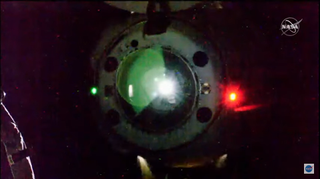SpaceX Dragon cargo ship returns to Earth with gravity-sensitive experiments
Dragon hauled home 4,600 pounds (2,900 kilograms) of science experiments and other gear.
SpaceX's Dragon cargo spacecraft returned to Earth Thursday night (Sept. 30), packed full of science experiments after one month at the International Space Station.
The capsule, carrying 4,600 pounds (2,900 kilograms) of science experiments and other gear, undocked at 9:12 a.m. EDT (1312 GMT) on Thursday, while the station was traveling over the Pacific Ocean. NASA astronaut Shane Kimbrough monitored from inside the International Space Station's cupola as the capsule, commanded by ground controllers at SpaceX headquarters in Hawthorne, California, detached from the station's Harmony module and fired its thrusters.
"I want to give a huge thank you to the SpaceX and the NASA teams for getting this vehicle up to us in great shape, with a lot of science and surprise for the ISS," Kimbrough said during a NASA livestream. "The activities associated with SpaceX 23 kept our crew busy over the past month. We look forward to hearing about the results of the payloads we interacted with. Have a safe journey back to Earth."
The capsule then moved to a safe distance from the station and performed a series of burns, which sent it toward Earth. Dragon ended up splashing down as planned off the coast of Florida, SpaceX confirmed via Twitter at 10:59 p.m. EDT Thursday (0229 GMT on Oct. 1).
Related: 3 astronauts move Soyuz to new space station dock ahead of film crew arrival

Dragon will be transported to NASA's Space Station Processing Facility at the Kennedy Space Center, which is located a short distance from the splashdown site.
This short distance is especially important for this shipment, since the capsule carries microgravity experiments that could be affected if exposed to the planet's gravity in an unprotected environment for a longer period of time, NASA officials wrote in a statement.
Get the Space.com Newsletter
Breaking space news, the latest updates on rocket launches, skywatching events and more!
Many of the experiments are biomedical, including some focused on the evolution of degenerative diseases such as Azheimer's, Parkinson's and Type 2 diabetes, as well as others examining muscle atrophy and gene expression in space.
Investigators will make a first quick assessment of the biological samples upon arrival at the processing facility before exposure to gravity alters the results. Then, the researchers will perform more in-depth analyses at their home laboratories.
The departing Dragon spacecraft had been docked at the space station since Aug. 30. The capsule, launched on Aug. 29 from Launch Complex 39A at the Kennedy Space Center, was SpaceX's 23rd Commercial Resupply Services mission for NASA.
The next cargo Dragon bound for the space station is currently targeting a launch in early December. The docking port on the Harmony module that the CRS-23 capsule occupied will next be visited by the upcoming Crew Dragon 3 mission this fall.
Editor's note: This story was updated at midnight EDT on Oct. 1 with news of Dragon's splashdown.
Follow Tereza Pultarova on Twitter @TerezaPultarova. Follow us on Twitter @Spacedotcom and on Facebook.
Join our Space Forums to keep talking space on the latest missions, night sky and more! And if you have a news tip, correction or comment, let us know at: community@space.com.

Tereza is a London-based science and technology journalist, aspiring fiction writer and amateur gymnast. Originally from Prague, the Czech Republic, she spent the first seven years of her career working as a reporter, script-writer and presenter for various TV programmes of the Czech Public Service Television. She later took a career break to pursue further education and added a Master's in Science from the International Space University, France, to her Bachelor's in Journalism and Master's in Cultural Anthropology from Prague's Charles University. She worked as a reporter at the Engineering and Technology magazine, freelanced for a range of publications including Live Science, Space.com, Professional Engineering, Via Satellite and Space News and served as a maternity cover science editor at the European Space Agency.
